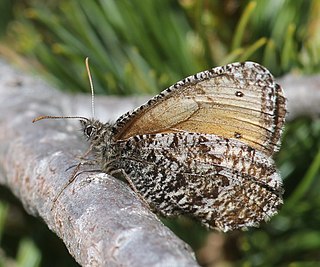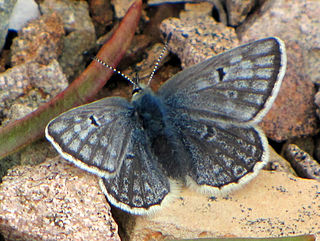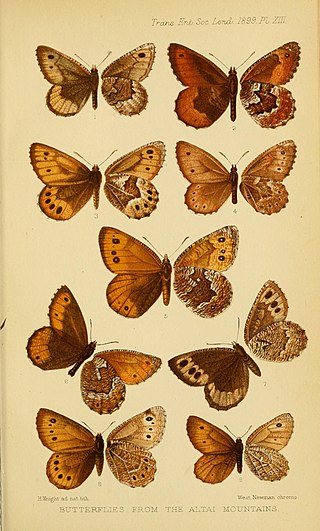
Lycaena phlaeas, the small copper, American copper, or common copper, is a butterfly of the Lycaenids or gossamer-winged butterfly family. According to Guppy and Shepard (2001), its specific name phlaeas is said to be derived either from the Greek φλέγω (phlégo), "to burn up", or from the Latin floreo, "to flourish".

Oeneis is a butterfly genus of the Satyrinae. All but one of its members are Arctic, sub-Arctic or high-altitude alpine in distribution. Some of the members of the genus are among the butterflies that can get along in the harshest climates of any butterflies. Four species in Europe, more are found in Arctic Russia, Siberia, Mongolia, Arctic North America and the Rocky Mountains. Curiously, there are no observations from Greenland. The development of most species takes two years.

Oeneis chryxus, the chryxus Arctic or brown Arctic, is a butterfly of subfamily Satyrinae found in the far northwest regions of Canada and the United States. The brown Arctic has highly variable colorings, which tend toward light yellow to orange brown wings that help camouflage it against its mountainous rocky habitat. The larvae feed on local grasses and take two years to develop. This longer development period results in flights of adult brown Arctics only once every two years. The butterflies feed on nectar from various plants as their primary food source.

Oeneis jutta, the Jutta Arctic or Baltic grayling, is a species of butterfly in the subfamily Satyrinae with a Circumboreal distribution. It occurs in bogs and tundra in the north of Europe, the Baltic states, the Urals, Siberia, northern Kazakhstan, the Russian Far East, northern Mongolia, northeastern China, North Korea, and northern North America. Larvae feed on Carex and Eriophorum, possibly also Glyceria, Molinia, and Juncus. Ledum palustre is the preferred nectar plant of the adult butterflies. The species has one generation every one or two years, depending on the location.

Oeneis norna, the Norse grayling, is a species of butterfly in the subfamily Satyrinae, that occurs throughout Scandinavia and the northern Palearctic.

Agriades glandon, the Arctic blue or Glandon blue, is a species of butterfly in the family Lycaenidae. It in found in Eurasia and North America.

Oeneis nevadensis is a species of butterfly in the family Nymphalidae. It is commonly known as the great Arctic, Nevada Arctic, great grayling, Felder's Arctic, or Pacific Arctic. It is native to northwestern North America.
Oeneis alpina, the sentinel Arctic or Eskimo Arctic, is a species of butterfly in the subfamily Satyrinae. It occurs in Siberia and the northern parts of North America.

Oeneis tarpeja is a species of butterfly in the family Nymphalidae. It is found from the Caucasus and Volga region across Kazakhstan and southern Siberia to the Amur region and Mongolia. In Ukraine this species became extirpated in the mid-twentieth century. The habitat consists of steppe-clad plains and foothills.

Oeneis melissa, the Melissa Arctic, is a species of butterfly in the family Nymphalidae.

Oeneis magna is a butterfly of the family Nymphalidae. It was described by Ludwig Carl Friedrich Graeser in 1888. It is found from the Altai Mountains to southern Siberia and the Russian Far East, Mongolia, northern China and Korea. The habitat consists of sparse woodlands and mountain tundras.

Oeneis urda is a butterfly of the family Nymphalidae. It was described by Eduard Friedrich Eversmann in 1847. It is found from Russia to northern Mongolia, north-eastern China and Korea. The habitat consists of steppe-clad slopes.

Oeneis bore, the white-veined Arctic or Arctic grayling, is a butterfly, a species of Satyrinae that occurs in North America and Asia.
Oeneis macounii, the Canada Arctic or Macoun's Arctic, is a butterfly of subfamily Satyrinae that occurs in North America.
Oeneis polixenes, the Polixenes Arctic or Norique Alpin, is a species of butterfly in the subfamily Satyrinae. It has a Circumpolar distribution occurring in northern parts of North America the Arctic Urals, Kamtchatka, Yakutia, Chukchi Peninsula, and northern Siberia.

Erebia discoidalis, the red-disked alpine, is a member of the subfamily Satyrinae of family Nymphalidae. It is found in North America from eastern Quebec, through northern Ontario, and the northern Prairies to northern British Columbia, the Northwest Territories, Yukon, and Alaska. It reaches just into the northern U.S. between Michigan and Montana, and also occurs in Asia, where it has been recorded from the Chukot Peninsula to the eastern Sayan Mountains and Amur. The habitat consists of large, open, grassy bogs and other areas with acidic soils.
The arctic Katahdin butterfly is a subspecies of the polixenes arctic. This particular butterfly is considered endangered because it only appears on Mount Katahdin in the State of Maine, and its small population fluctuates every year.












